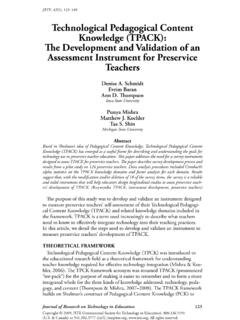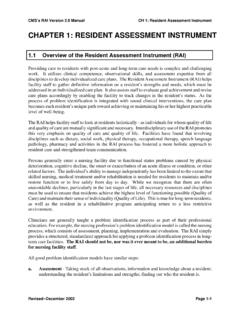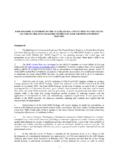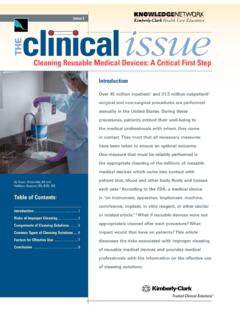Transcription of The Evaluation Process in 10 Steps
1 The Evaluation Process in 10 Steps a GuidelinePublished byBrot f r die Welt Evangelischer EntwicklungsdienstEvangelisches Werk f r Diakonie und Entwicklung e. e 110115 Berlin, GermanyTelephone +49 30 65211 Derbinski, Thomas ReinhardtEditorDietmar M lzerLayoutNORDSONNE IDENTITYB erlin, June 2017 The Evaluation Process in 10 Steps a GuidelineForeword ..5 Steps of an Evaluation ..6 Evaluation Introduction ..9 step 01 Planning and Budgeting ..14 step 02 Terms of Reference (ToR) ..16 step 03 Obtaining Offers ..23 step 04 Selecting Evaluators ..24 step 05 Concluding the Contract ..28 step 06 Kick-off and Clarification Meeting ..30 step 07 Inception Report ..33 step 08 Debriefing/Presentation of the Results ..35 step 09 Assessment of the Final Report ..37 step 10 Dealing with the Results of Evaluations ..41 Table of Contents5 Evaluations are becoming increasingly important in international development cooperation. External evaluations are used to provide accountability towards donors and much more importantly to learn from the experiences and assessments of external order for evaluations to satisfy both the requirements of the implementing organisation and donors requirements, it is important that the Process is properly planned and supported and that the scheduled timescale is do I start planning?
2 What constitutes high-quality Terms of Reference? How do I assess whether a report is good or bad? These are typical questions that arise during an Evaluation pro-cess. These guides have been produced to provide employees and partner organisations of Brot f r die Welt Evangelischer Entwicklungsdienst (Bread for the World Protestant Development Service) with practical assistance during the Evaluation Evaluation Process has been divided into ten Steps . A guide has been produced for each of these Process Steps . The guides can be used independently of one another. There is also an intro-ductory guide that contains basic information about the topic of Evaluation . The data-collection step is performed by the external evaluators, meaning that there is no guide for this guide explains what needs to be considered during this step , why it is important and who needs to be involved. The aim is to provide important tips and assistance as to how the individual Steps can be implemented.
3 The guides are specifically tailored to external evaluations, but they also contain relevant information for other Evaluation forms. All guides are available in the five languages of communication of Bread for the World Protestant Development Service (Bread for the World).The guides and their attachments/tools should be understood as aids: there is no obligation to use them. For details on Bread for the World s stipulations regarding Evaluation , please refer to the document Requirements for implementation of project evaluations in the enclosure to cooperation agreement. However, please note that other donors may have other stipulations that also need to be taken into for the World is always available for any questions and suggested improvements you may Guideline | Version as of June 2017on application/planning of the project or as soon as the need is identifiedapprox. one weekreview donors stipulations regarding evaluationssecure funding, fix budget broadly define the objectives and form specify time point taking into account the framework conditions (access to project region, availability of target groups and employees etc.)
4 After finishing the Terms of Reference (ToR)approx. 4 weeks (in consideration of the submission period)distribute the Terms of Reference to known evaluators, via Internet forums, networks the selection of the evaluatorsone day to two weeksdraft the contracthave the contract signed by all contracting partiesWhenDurationLegendat least ten weeks prior to the planned field phaseapprox. 4-6 weeksidentify the stakeholders and interested parties and how they will be included over the course of the Evaluation (point in time, form)prepare the Terms of Reference, potentially in conjunction with other stakeholderspromptly after submission period endsat least one weekreview offers receivedselect the evaluators, potentially in conjunction with other stakeholdersdocument and justify the decision1 As the data is collected by the external evaluators, there is no guide for this step . Steps of an EvaluationPreparationPlanning and BudgetingObtaining OffersConcluding the Contract010305 Drawing up the Terms of ReferenceSelecting Evaluators020401020305047approx.
5 One week following the Kick-off and clarification meetingapprox. 1-2 weeksdiscuss and approve the in-ception reportfollowing receipt of the draft report up to two weeks following receipt of the draft report review the draft report and request any correctionsapprove the final reportif stakeholders or target groups need to be visited, a run-up of at least two weeks prior to the field visit must be scheduledapprox. one daycompile material, documents, contacts and provide them to the evaluatorsdiscuss dates with the evaluators and other stakeholders, as well as logistical and other necessary support plus content-related, methodological, formal expecta-tions, boundaries and optionsfollowing receipt of the final reportapprox. two months to draw up an implementation plandiscuss the results and recommenda-tions with stakeholdersdraw up an implementation planwhere relevant: make the Evaluation report available to a broad public ( on the Internet)notify relevant, interested actors of results and recommendations and where relevant of planned utilisation implementation and monitoring of the implementation planat the end of the field phase or prior to submission of the final reporthalf a day to one dayat the end of the field visits the evaluators present the collated data and preliminary results to the target groupthe results and recommendations are presented to the commissioning organisation and potential other stakeholders and interested parties (representatives of the target group, state actors etc.)
6 At a debriefing ses-sion/presentationData-collation phase1 Implementation Utilisationthe commissioning organisation supports evaluators as agreeddocuments and information are made available If needed, help with logistics, appointments and communication is providedReporting by the evaluatorsInception ReportAssessment of the Final Report0709 Kick-off and Clarification MeetingDealing with the ResultsDebriefing/Presentation of the results0610080607080910 Evaluation Guideline | Version as of June 201789 Definition:To evaluate means to assess, analyse, appraise. In international cooperation Evaluation is defined as The systematic and objective assessment of an ongoing or completed project, programme or policy, its design, implementation and results. The aim is to determine the relevance and fulfillment of objectives, development efficiency, effectiveness, impact and Evaluation should provide information that is credible and useful, enabling the incorporation of lessons learned into the decision-making Process of both recipients and donors.
7 OECD-DAC Glossary1W hy Evaluation ?Evaluations have two key objectives: Learning by all stakeholders, target groups, part-ner organisations, Bread for the World, donors and other actors, often in conjunction with other institu-tions and organisations in development cooperation with whom the results will be shared, and Accountability towards donors (private donors, co- financers, etc.).What is evaluated?The object of the Evaluation , what is being evalu-ated, may vary substantially. Examples of this may include: one or more individual project component(s) a project (project Evaluation ) several projects with the same thematic thrust (over-arching Evaluation ) a higher-level programme comprising multiple pro-jects ( all projects in a country) a (sector) policy an instrument, an approach to work an organisation or individual directorates or pro-cesses of an implementing organisation ( PME, finance systems, HR or management structure).
8 Who evaluates?Evaluations may be conducted in different ways, as a self- Evaluation by the people responsible for the implementation of the project/programme as an internal Evaluation , by people who, although they work in the same organisation that is imple-menting or financing the project/programme, are not involved in its execution as an external Evaluation by external, independent evaluators1 OECD DAC: Glossary of Key Terms in Evaluation and Results Based Management, 2009 Evaluation IntroductionEvaluation Guideline | Version as of June 201710 Overview: Who will realise the Evaluation and which points should be consideredSelf-evaluationInternal evaluationExternal relatively low as normally no fee for an external evaluator is relatively low as normally no fee needs to be paid for an external evaluator..are relatively high because an external evaluator needs to be paid for, often including their transport and accommodation.
9 Non-mone-tary over-h e a d (t i m e , personnel etc.)..can be high as at least one person from the project/organi-sation will need to be heavily involved in the preparation (methodology, questions etc.) and relatively high for the implementing person, but the overhead is limited given that the person already knows the organisation and the frame-work conditions..are not necessarily lower as the Terms of Reference need to be drafted, the tender proce-dure organised and the selec-tion made. Additionally, exter-nal evaluators often do not know the project and the stake-holders, meaning that a com-paratively large amount of time needs to be invested in informa-tion, communication and organisation. Possible negative effects to be consideredDepending on cultural condi-tions and prerequisites within the team, it may be difficult or even impossible for the team-members to engage criti-cally with themselves and their work and any potential improvements.
10 Within the team care must be taken to ensure that the results and recommendations are related to the project/organisa-tion and accepted in that spirit and not taken amiss from the person conducting the evalua-tion. Similarly, the neutrality of the person conducting the eval-uation must be guaranteed. Depending on the personality and prior knowledge of the external evaluator, it can be dif-ficult for him/her to understand the project as a whole and its framework conditions. Simi-larly, it must always be ensured that all stakeholders are treated with the respect due and that anonymity is guaranteed. Possible positive side-effectsThe team-members can learn not only that they are responsi-ble for success, but also that they can influence the design. Learning from each other within the organisation and an exchange of ideas can be fos-tered, with the result that more of colleagues existing insights and knowledge can be fed into the implementation Process .






